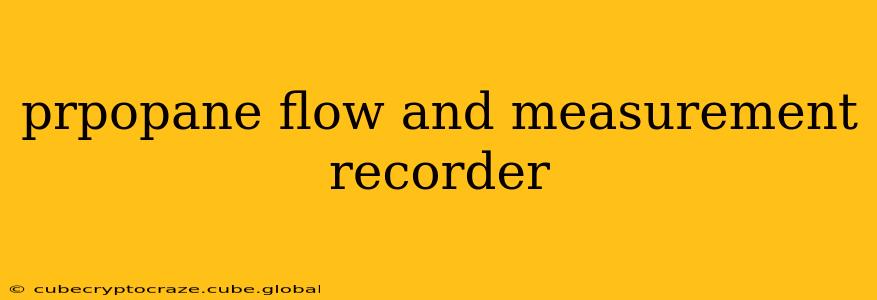Accurate propane flow measurement is crucial for various applications, from residential heating systems to large-scale industrial processes. Understanding how propane flow is measured and recorded is essential for safety, efficiency, and cost management. This guide delves into the different types of propane flow and measurement recorders, their applications, and key considerations for selection and implementation.
What are Propane Flow and Measurement Recorders?
Propane flow and measurement recorders are devices that monitor and record the volume or mass flow rate of propane gas moving through a pipeline or system. They provide real-time data on propane consumption, allowing for better inventory management, leak detection, and process optimization. These recorders are vital for ensuring efficient and safe propane utilization across various sectors.
Types of Propane Flow Measurement Technologies
Several technologies are employed for measuring propane flow. The choice depends on factors like accuracy requirements, pressure and temperature conditions, and budget. Common methods include:
-
Positive Displacement Meters: These meters precisely measure the volume of propane by trapping and counting discrete volumes of gas. They are highly accurate but can be more expensive and less suitable for high-flow applications.
-
Turbine Meters: These meters utilize a turbine that spins at a rate proportional to the gas flow rate. They offer good accuracy and are suitable for a wider range of flow rates than positive displacement meters.
-
Ultrasonic Meters: These meters employ ultrasonic waves to measure the velocity of the propane flowing through a pipe. They are non-invasive and suitable for high-pressure and high-temperature applications.
-
Orifice Plates: These are simpler, less expensive flow restrictors that create a pressure drop proportional to the flow rate. The pressure difference is measured to calculate flow. While less precise than other methods, they're often used in less demanding applications.
What are the Key Features of a Propane Flow Recorder?
Beyond the measurement technology, several key features differentiate propane flow recorders:
- Accuracy: The precision of the flow measurement is critical for billing accuracy and process control.
- Data Logging: The ability to store flow data over time is essential for analysis and trend identification. Many recorders offer different data logging intervals and storage capacities.
- Communication Protocols: Modern recorders often integrate with supervisory control and data acquisition (SCADA) systems through various communication protocols (e.g., Modbus, Ethernet/IP).
- Display and Interface: A clear and user-friendly display is essential for real-time monitoring. Some recorders offer remote access capabilities.
- Durability and Reliability: The recorder must withstand the environmental conditions of its application, including temperature fluctuations and potential exposure to harsh elements.
What are the different types of propane flow meters?
This question is addressed above in the "Types of Propane Flow Measurement Technologies" section. Different meter types (positive displacement, turbine, ultrasonic, orifice plate) offer varying levels of accuracy, cost, and suitability for different flow rates and applications.
How is propane flow measured in a large-scale industrial setting?
Large-scale industrial settings often utilize turbine meters, ultrasonic meters, or orifice plates for propane flow measurement due to their ability to handle high flow rates and integrate with existing SCADA systems. The specific choice depends on factors like required accuracy, pressure, and temperature conditions. Advanced systems might incorporate multiple measurement points for redundancy and improved accuracy.
What are the benefits of using a propane flow recorder?
The benefits of using a propane flow recorder include:
- Accurate Inventory Management: Precisely track propane consumption to avoid shortages or overstocking.
- Improved Efficiency: Identify areas of inefficiency and optimize propane usage.
- Leak Detection: Detect leaks early, minimizing environmental impact and potential safety hazards.
- Cost Savings: Optimize propane usage and reduce unnecessary expenditures.
- Compliance: Meet regulatory requirements for accurate propane accounting.
How do I choose the right propane flow recorder for my needs?
Selecting the right propane flow recorder depends on several factors:
- Flow Rate: Determine the range of propane flow rates expected in your application.
- Accuracy Requirements: Identify the level of accuracy needed for your specific needs (e.g., billing, process control).
- Pressure and Temperature: Consider the operating pressure and temperature conditions.
- Budget: Balance cost with desired features and performance.
- Communication and Integration: Ensure the recorder is compatible with your existing systems and software.
Choosing and implementing the right propane flow and measurement recorder is crucial for efficient and safe operation across various applications. By understanding the available technologies and their features, you can select a system that meets your specific requirements and enhances your operational efficiency.
